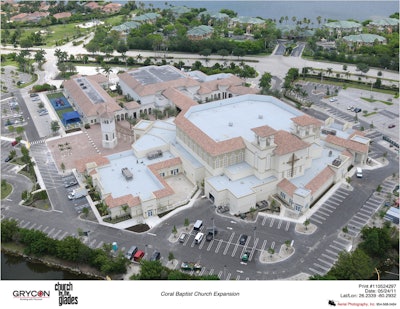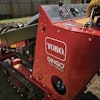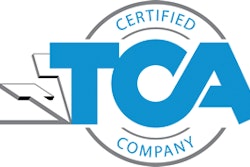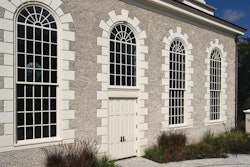
Clay Fischer, CEO of Woodland Construction Co., Jupiter, Fla., first got involved in tilt-up construction while working as a superintendent for a general contractor in Atlanta, Ga., in the 1980s. In those days tilt-up was still gaining popularity and Clay identified the construction method as an emerging niche in the concrete industry with potential for growth and a chance for him to build his own firm specializing in tilt-up.
Clay got a break when his former employer was unable to finish five tilt-up projects and a bonding firm hired him to finish them. In 1987, Clay and his wife, Jeanne, started Woodland Construction, becoming one of the first tilt-up subcontractors in the country. Clay’s brother, Gary Fischer, started at Woodland eight months later. With their first set of projects under their belts and the tilt-up method gaining acceptance throughout the southeastern United States, other owners and general contractors in the region took notice and approached Woodland to manage their tilt-up projects. Today Woodland Construction Co. is the fourth largest tilt-up contractor in the United States, focusing on unique and challenging jobs for customers in South Florida and beyond.
Building a business
Establishing a company, identifying your strengths and having the business wherewithal to keep your growth path focused around those strengths is a difficult proposition. Throw in the realities of business, including economic fluctuations, government regulations and customer relations, and your odds of succeeding become a challenge. Woodland Construction weathered several economic waves over the company’s history. Clay says the first couple years started strong, but a recession hit in the early 1990s forcing the company to trim its employee rolls from 100 workers to 12. The market came back in 1992, but shortly after the widely destructive, Category 5 Hurricane Andrew hit South Florida, bringing businesses, construction and life in general to a standstill while the area rebuilt.
In the mid- to late-1990s Woodland was again experiencing a strong economy and its management team worked to move the company forward with controlled growth. The company was met with growing pains, however, having difficulty keeping some foremen and superintendents motivated and maintaining quality in the field. “Our employees didn’t understand the business,” Clay says. “They knew the forming and construction side of things but didn’t understand how their work affected the company.”
A turning point came in 1997 when Woodland embraced the principles of open book management, sharing financials with its employees and educating them on the business side of the company by holding ‘Business 101’ courses for foremen, superintendents and people in estimating.
“We also stopped putting up with crap,” Clay says. “We made sure employees knew things needed to be done ‘the Woodland Way.’ Once we got tough, life got better. And we realized some employees just weren’t a fit.”
The easy life
With an effective business model in place and motivated employees working toward a quality end product, Woodland Construction was in a position to build the company it is today — a company focused on making tilt-up a logical choice for its customers. Through ease of scheduling, value engineering and problem solving experience on complicated projects, Woodland can deliver its customers a quality building without hassle whether the customer comes to Woodland with a job or Woodland pursues them. “We strive to make our customers’ lives as easy as we can,” Clay explains.
Many jobs come to Woodland through the design community. Woodland has built close, symbiotic relationships with several engineering and design firms in South Florida. “These companies know they can come to us and say, This is what we want. How do we build it?” Clay says. He adds that Woodland wins about 75 percent of the bids where it assisted in the design phase of the project.
Whether a project comes to Woodland or it’s a job they pursue, the company focuses on winning the total structural package. “There is a tremendous amount of coordination required for these jobs, and when we are awarded a structural package we can alleviate that responsibility from the general contractor or owner,” Clay says.
Woodland works closely with both precast and structural steel companies to help them achieve this coordination. It also has a long-standing relationship with a placing and finishing firm that specializes in producing high-quality floors and tilt-up panels. Woodland’s panel erection is done by a sister company while Woodland’s own employees perform carpentry work, rod busting, panel welding and panel detailing at the end of the project. “Because of the complex projects we do, we have to have control over the entire process,” Woodland President Gary Fischer says. “Even if a panel is set down two inches off from the plan, it can throw everything else off.”
Adjusting in today’s market
The current economic downturn hit hard in Florida. It forced Woodland to trim its employee roll from 400 to 60. The company took other measures to cut costs. It gave up its fleet of pick-up trucks and went with a vehicle leasing program, putting project managers — and Clay and Gary — in fuel-efficient sedans while field crews got fuel-efficient SUVs. Management took a 30 percent pay cut and looked for other ways to trim costs at the company. “You find out how many things you didn’t think were negotiable are negotiable,” Gary says. That included the telephone contract, dumpster contract, even the vehicle leasing contract.
Not all the changes were cuts, however. In 2009 Woodland bought out a competitor, absorbing some of its management team into the Woodland crew. The company also hired a new employee to focus on business development, focusing on gaining new customers and finding new applications for tilt-up construction.
Woodland also started to look for work beyond its traditional borders. “We used to have more jobs than we could handle in Southeast Florida,” Clay says. “Now we are traveling to North Carolina and Southwest Florida.”
With all the changes in the economy and the company, it took Woodland some time to figure out how to react. What the management team realized was they just needed to stay focused on the company’s strengths. “We got scared and bid out of our comfort zone,” Clay says. “It wasn’t long before we decided not to do that anymore.”
The management team recognized the company needed to continue bidding and building the out-of-the-ordinary projects it specialized in. “We won’t bid warehouse jobs; we want the unique projects. If it’s something we can design assist on, or something we can offer a complete package on, we will bid it,” Clay says. “We see a lot of new competition entering the market every day, but they’re not at our same level and don’t have our reputation or longevity.”
“We’re not a commodity,” Gary adds. “That’s what separates us from our competition. We are award winners. We have a reputation of quality and we are good folks to do business with. The proof is we have a lot of repeat work with customers.”
Clay says in order to win projects they wanted to build in this market they have had to come up with innovative solutions for their customers’ jobs, and often work to flip projects planned for other construction methods to tilt-up. One of those projects was a dormitory at Florida Atlantic University in Boca Raton, Fla. The four-story building was originally planned for tunnel construction with masonry cladding. Woodland was able to convince the owner to skin the building with tilt-up panels instead, resulting in a 15 percent reduction in the construction costs of the cladding. "Any time we can save an owner money, we've gained a loyal customer. Building a job right and money savings are important to building owners," Gary says.
With the construction market currently stuck in neutral, Clay predicts it will take a few years for Florida to find its new normal, adding he doesn’t expect it to be anywhere near as active as it was five years ago. And that’s OK with Woodland Construction as its management team looks to find its own new normal in the construction market. “We want to find that sweet spot where we’re not killing ourselves working and we have a good quality of life,” Clay says. “We were making almost $100 million in sales at one time. We did very well, but it was stressful. I want us to become a boutique contractor, working unique and fun projects that will hopefully make us some money, too.”




















